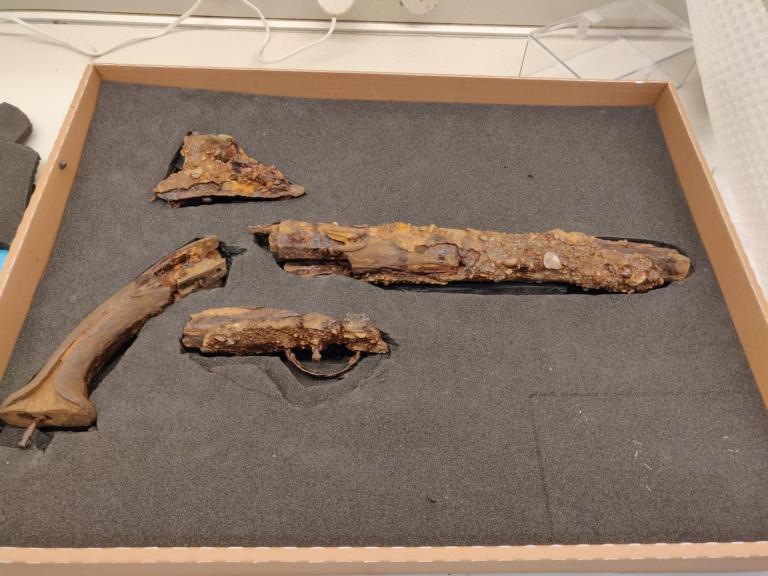
A few months ago, the geology collection manager discovered a gun in her collection. Happily, it was no cause for emergency. This was not a modern gun by any means, but an old flintlock pistol broken into four large pieces. What was it doing in a natural history museum? Well, this weapon spent centuries in the bottom of a river in Amsterdam. Over time the pebbles and stones from the riverbed became attached to the metal as it rusted and the gun became a wonderful example of a modern geologic conglomerate.
Work was needed to conserve this object as it had become friable and many stones from the conglomerate and pieces of wood from the stock were falling off. These loose bits were collected and boxed up: they will come in handy for future research requests. The remaining pieces of the specimen: barrel, stock, trigger and the flintlock mechanism were treated with B-72 to prevent further disintegration. Finally, a custom cushion for the gun was cut out of acid free foam, and the pieces of the gun laid out in such a manner to represent how it must have looked before it fell apart. The whole cushion was fit in an archival box.
There are some interesting historical associations with this gun, and Martin Ijdo at Historic Engineering kindly helped us puzzle it all out. According to Martin, this gun is typical of the 17th century. Pistols at this time were used in the military or for self defence. The 17th century was quite a momentous one here in the Netherlands. For the first half of the century, the Dutch were involved in the 80 years war, fighting for Independence from Spain. During the war, the nation became one of the biggest arms manufacturers in the world. Due to the degradation of the metal parts of the pistol, we cannot make too many inferences about the exact manufacture of this particular specimen, though it does resemble guns made here at that time. A botanic archeologist, Yvonne van Amerongen from Archeon, took a look at some wood fragments from the weapon and identified the wood as a type of walnut. Hopefully in the next few months she can to more sleuthing into this interesting specimen. One of the intriguing elements Martin noticed was that the flintstone was is still in place, which implies the gun was in use when lost. Mid battle, perhaps?
One of the reasons why repairing this specimen became a priority, despite the fact that right now we are busy with the movement of the collections and exhibits into our new building, is because this gun is going to go on into the new Live Science Hall. In this hall (by popular demand) we will have changing vitrine of the favorite objects from the Naturalis staff. Arike Gill, the collection manager for Geology who found this object, has chosen this as her favorite. If you want to know why you will have to come see for yourself after we open at the end of summer 2019!
Written by Becky Desjardins,
Taxidermist